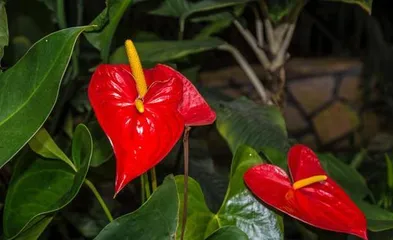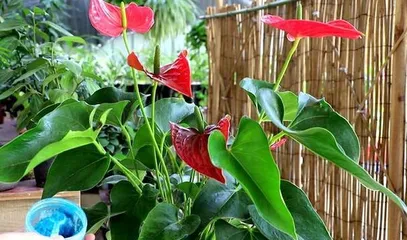Anthurium is a very beautiful plant and one of the popular indoor plants that many people like to grow. However, many people don't know how many times Anthurium blooms in a year or how to care for it to maintain a long flowering period. This article will introduce the flowering time of Anthurium and how to care for it, so that your Anthurium can bloom continuously.

I: Overview of Anthurium
Anthurium (Latin name: Anthurium andraeanum) is a plant of the Araceae family, a cold-tolerant evergreen herbaceous plant, mainly distributed in tropical and subtropical regions, growing in a shady and humid environment. Its characteristics are heart-shaped leaves and heart-shaped flowers, which come in many colors, including red, pink, white, and purple.
II: Flowering Period of Anthurium
Anthurium blooms twice a year, in spring and autumn. During the flowering seasons in spring and autumn, Anthurium will produce many beautiful flowers, allowing people to feel the beauty of life. In other seasons, Anthurium may also bloom, but in smaller quantities.

III: Light Requirements for Anthurium
Anthurium prefers scattered light and should not be directly exposed to strong sunlight. If exposed to sunlight for a long time, it will cause the leaves to turn yellow or fade. Place the Anthurium in a semi-shady or dark place to maintain scattered sunlight.
IV: Temperature Requirements for Anthurium
Anthurium is a tropical plant and is sensitive to environmental temperatures. It needs a warm environment to grow and bloom normally. In spring and autumn, Anthurium needs to be kept at a temperature of about 20°C, while in other seasons, it needs to be kept at about 25°C.
V: Humidity Requirements for Anthurium
Anthurium is a plant that likes a humid environment. During the flowering period in spring and autumn, the soil needs to be kept moist, but not overwatered. In other seasons, the frequency of watering can be appropriately reduced. You can place the potted plant on a tray to increase the humidity.

VI: Fertilization Method for Anthurium
Anthurium needs regular fertilization, once a month. During the flowering seasons in spring and autumn, more fertilization should be applied. You can use fertilizers with high nitrogen, high phosphorus, and high potassium to extend the flowering period.
VII: Pruning Method for Anthurium
Anthurium requires regular pruning and shaping. When bad branches or leaves grow, they should be trimmed off in time. During the flowering seasons in spring and autumn, the flower stalks can be cut off to maintain its vitality.
VIII: Propagation Methods for Anthurium
Anthurium can be propagated by division and cuttings. When taking cuttings, use healthy branches and insert them into suitable soil, then maintain a humid environment. When dividing, select healthy plants and divide them into several parts, then plant them in suitable soil.
IX: Pest and Disease Control for Anthurium
Anthurium is susceptible to aphids and mites. When aphids and mites are found, immediate measures should be taken for control. You can use soapy water or pesticides for spraying, or use a cotton swab dipped in alcohol to clean them.
X: Common Problems with Anthurium
During the growth process, Anthurium may encounter some problems, such as yellowing leaves or a short flowering period. These problems may be caused by improper care. To avoid these problems, the growth of Anthurium should be checked regularly, and appropriate measures should be taken to correct them.
XI: Ornamental Value of Anthurium
Anthurium is not only a beautiful plant but also has high ornamental value. Placing Anthurium in your home can increase the indoor oxygen content, improve indoor air quality, and add a touch of natural beauty.
XII: Uses of Anthurium
In addition to being an ornamental plant, Anthurium also has certain medicinal value. According to research, the rhizomes of Anthurium are rich in medicinal ingredients and can be used to treat symptoms such as indigestion and diarrhea.
XIII: Historical Origin of Anthurium
Anthurium has been known since ancient times and has been widely used in fields such as landscape design and medicine. In Europe, Anthurium is regarded as a noble plant and one of the best in flower potted plants.
XIV: Market Prospects for Anthurium
Due to its ornamental and medicinal value, Anthurium has broad market prospects. As people pay more attention to the ecological environment and the concept of green and health, Anthurium is expected to become a star plant in the flower market.
XV:
Anthurium is a beautiful and noble plant. To care for Anthurium at home, you need to pay attention to aspects such as light, temperature, humidity, fertilization, and pruning. Only with the correct care methods can Anthurium bloom continuously, improve indoor air quality, and add beauty to your home.